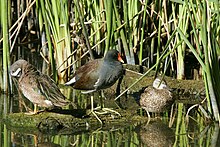Santa Ana National Wildlife Refuge
| Santa Ana National Wildlife Refuge | |
|---|---|
IUCN category IV (habitat/species management area) | |
 Map of Texas | |
| Location | Hidalgo County, Texas, United States |
| Nearest city | Alamo, Texas |
| Coordinates | 26°4′59″N 98°8′6″W / 26.08306°N 98.13500°WCoordinates: 26°4′59″N 98°8′6″W / 26.08306°N 98.13500°W |
| Area | 2,088 acres (845 ha) |
| Established | 1943 |
| Governing body | U.S. Fish and Wildlife Service |
| Website | Santa Ana National Wildlife Service |
| Designated | 1966 |
Santa Ana National Wildlife Refuge is a 2,088-acre (8.45 km2) National Wildlife Refuge situated along the banks of the Rio Grande, south of Alamo in the Lower Rio Grande Valley, in Hidalgo County, South Texas.
The wildlife refuge was established for the protection of migratory birds in 1943. Its unique location is at the meeting of different climates and habitats: subtropical wetlands, Chihuahuan Desert, Gulf Coast, and Great Plains. Its riparian location has developed a reputation for diverse birding.
Due to its location near the Mexico–United States border, this wildlife refuge is threatened by the Trump wall.[1]
Fauna[]

Notable species among the fauna in the refuge include the Texas ocelot (Leopardus pardalis albescens) and Gulf Coast jaguarundi (Puma yagouaroundi cacomitli) feline species.
Both species are listed as endangered in the Endangered Species Act of 1973, as Amended. The Texas ocelot is listed in the Convention on International Trade in Endangered Species of Wild Fauna and Flora (CITES) Appendix I and the Gulf Coast jaguarundi (seen at left) is listed in the CITES Appendix II.
While not considered endangered by the International Union for Conservation of Nature (IUCN), these species are acknowledged as rare for the area.
Birds[]

397 bird species have been documented within the park's borders. Many of those are migratory species on their way to and from Central and South America.
A few species to be found there are black-bellied whistling-duck, fulvous whistling-duck, mottled duck, blue-winged teal, green-winged teal, cinnamon teal, least grebe, anhinga, tricolored heron, white ibis, lesser yellowlegs, long-billed dowitcher, and least tern.

Osprey, broad-winged hawk, northern harrier, and peregrine falcon are among the migratory birds of prey found in the refuge. Hook-billed kite and gray hawk, seen occasionally in the refuge, attract birders from around the world.
More than 35 species of New World warblers have been seen, including the golden-winged warbler, magnolia warbler, Northern parula, tropical parula, American redstart, palm warbler, and yellow-breasted chat.
Butterflies[]

Santa Ana is home to almost half of all butterfly species found in the United States. More than 300 species of butterflies have been observed at the refuge, with as many as 65 having been seen on a single day.
References[]
- ^ Guerra, Luciano. "Perspective | I voted for Trump. Now his wall may destroy my butterfly paradise". Washington Post. ISSN 0190-8286. Retrieved 2020-09-15.
External links[]
- Fws.gov: Official Santa Ana National Wildlife Refuge website
- Texas Parks and Wildlife: Santa Ana NWR trails
| Wikimedia Commons has media related to Santa Ana National Wildlife Refuge. |
- IUCN Category IV
- National Wildlife Refuges in Texas
- Protected areas of Hidalgo County, Texas
- Lower Rio Grande Valley
- Wetlands of Texas
- Protected areas established in 1943
- National Natural Landmarks in Texas
- 1943 establishments in Texas
